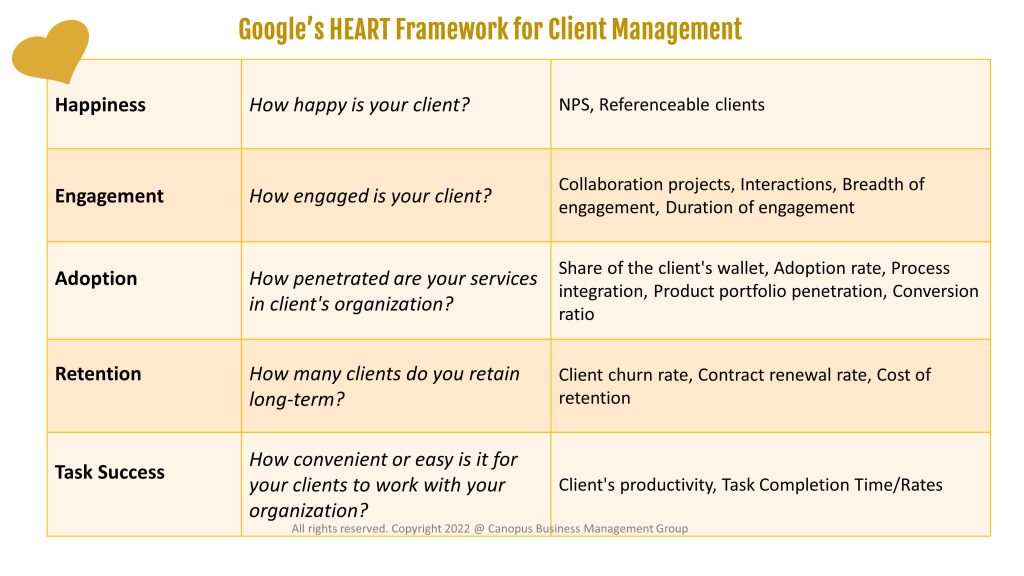Google’s HEART framework for your Client Centricity Program

Putting Google’s HEART framework to build your Client Centricity Program
A decade ago, Google’s researchers, Kerry Rodden, Hilary Hutchinson, and Xin Fu, published a paper on how to measure the UX of web applications. Their principal objective was to clarify how product goals can be mapped to metrics in order to improve the customer experience. This was the genesis of Google’s HEART framework.
Since then, this has gained popularity among product managers (PMs) and IT companies building products or applications. They use the HEART framework to improve UX. But I’m not going to talk about it in that context. Let’s take a step back and look at this HEART framework from the perspective of any business, and how we can use it to build client centricity.

What is Google’s HEART Framework?
HEART is an acronym for Happiness, Engagement, Adoption, Retention and Task. These are the five broad themes or lenses through which the success of client centricity and client management frameworks can be examined.
Happiness
How happy is your client? How happy are the decision-makers? How happy is the buyer of your service? How happy are the users of your services? How happy are the influencers?
While NPS is still a popular way to measure satisfaction, you can certainly explore other ways to collect quantitative data around satisfaction, for instance through referenceable clients.
Engagement
How engaged is your client in the short term? How much do users interact with a product or service?
We need to recognize that not all engaged clients are happy. For example, if they are reliant on your organization and you are failing to meet their expectations, their engagement with your organization will be high! They will have multiple reviews, too many reports, frequent visits to your site, etc.
Thus, measuring engagement alone can be misleading.
Engagement can also increase when you offer a wider range of products or services or multiple value additions. Mapping the client journey (CJM) can be helpful to improve positive engagement.
Relevant metrics would be collaboration projects, number of interactions, breadth of engagement (across different departments of the client’s organization), duration of such engagements, etc.
Adoption (Penetration)
How penetrated are your services in client’s organization? What is your share of wallet of the client’s business? How much are your existing clients willing to use your products, services, or applications? Are they regularly using it? Is it out of pressure or because they find it useful?
Relevant metrics can be the share of the client’s wallet, the adoption rate of your services, the adoption rate of new features, services, value adds, processes, integration between the client and your processes, the product ranges of clients where your services or products are used, the conversion ratio of sales, etc.
Retention
How many clients do you retain long-term?
Relevant metrics include client churn rate, contract renewal rate, cost of retention (discounts towards retention), etc.
Task
How convenient or easy is it for your clients to work with your organization? How complicated are the processes and policies? How agile is your work force’s mindset?
Prof. Clay Christensen introduced the concept of ‘Jobs-to-be-done’, where he stated that all clients and customers have jobs to be done, and it is about how we, as vendors, can make their lives easy. And clients (and their employees) would prefer those products or services that make their lives easier.
For example, your client wants you to change a design parameter for some specific reason, but your employees don’t easily accept the change. Instead, they resist, highlight difficulties, propose complicated solutions, put clients in bureaucratic loops, etc.
Metrics can be improvement in a client’s productivity (after your association), time to complete their tasks in your touchpoints, channels, or systems, etc.
I hope, by now, you can see the benefit of viewing your client centricity and client success program through Google’s HEART framework. If you are looking for any specific guidance in this area, please do contact me at Business.Support@collaborat.com
#nilakantasrinivasan-j #canopus-business-management-group #B2B-client-centric-growth #Google #HEART-Framework
